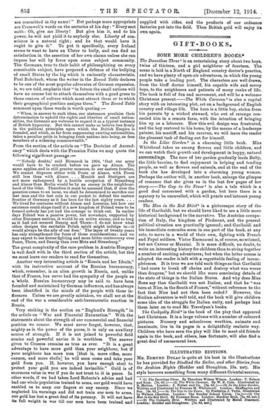GIFT-BOOKS,
SOME MORE CHILDREN'S 1300ItS.* The Dauntless Three' is an entertaining story about two boys, twins of thirteen, and a girl neighbour of fourteen. The scene is laid in a North of England country doctor's practice, and we have plenty of open-air adventures, in which the young people take a leading part. The characters are well drawn, from the bluff doctor himself, his capable wife and merry boys, to the neighbours and patients of many ranks of life. The book is full of fun and movement, and will be a welcome Christmas present —The White Caravan= is also a capital story with an interesting plot, set on a background of English country and village life. The hero is a little boy, stolen from his parents by a wicked steward, who out of revenge con- cealed him in a remote farm, with the intention of bringing him up as a labourer. How this evil design was frustrated, and the boy restored to his home, by the means of a landscape painter, his mastiff, and his caravan, we will leave the reader the pleasant task of finding out for himself.
In the Lilac Garden= is a charming little book. Miss Whitehead takes us among flowers and little children, and we can watch their growth and development in happy, natural surroundings. The care of her garden gradually leads Betty, the little heroine, to find enjoyment in helping and tending people, as well as flowers and animals, and at the end of the book she has developed into a charming young woman. Perhaps the author will, in another book, enlarge the glimpse of romance that she gives us in the last few pages of her story.—The Gap in the Fence' is also a tale which is a good deal concerned with a garden, but here there is a mystery to be unravelled, which will puzzle and interest young readers.
The .fan in the Red Shirts is a picturesque story of the life of Garibaldi, but we should have liked to see a little more historical background to the narrative. The Austrian occupa- tion of Italy, the kingdom of Piedmont, and the general political situation are practically ignored; and Garibaldi and his immediate comrades seem in one part of the book, at any rate, to move in a world of their own, fighting with French and Papal soldiers. Victor Emmanuel is, of course, mentioned, but not Cavour or Mazzini. It is more difficult, no doubt, to write an interesting history for children than to string together a number of exciting adventures; but when the latter course is adopted the reader is left with a regrettable feeling of incom- pleteness. It is true we are told such things as that Garibaldi " had come to break off chains and destroy what was worse than dragons," but we should like more convincing details of the state of things in the Italian States. And why does Miss Bone say that Garibaldi was not Italian, and that he "was born at Nice, in the South of France," without reference to the fact that Nice had not then been ceded ? However, the Sicilian adventure is well told, and the book will give children some idea of the struggle for Italian unity, and perhaps lead them later on to read Mr. Trevelyan's books.
The Cockyolly Bird 6 is the book of the play that appeared
last Christmas. It is a large volume with a number of coloured pictures. Nursery and schoolroom worthies, animate and inanimate, live in its pages in a delightfully realistic way. Children who have seen the play will like to meet old friends again in the book, and others, less fortunate, will also find a, great deal of amusement here.














































 Previous page
Previous page